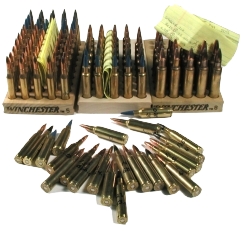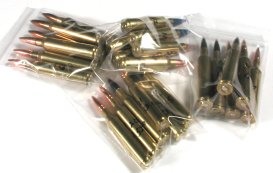 It’s not like I’m lazy, honest. I intended to wrap this up a couple of weeks ago. Then I ran into Christmas shopping, I had to order some more bullets, two of the test firearms needed scope installation, I think I was coming down with a cold, and my dog ate the web page… We’ll, maybe I have been goofing off a bit, but I believe I am finally done.
It’s not like I’m lazy, honest. I intended to wrap this up a couple of weeks ago. Then I ran into Christmas shopping, I had to order some more bullets, two of the test firearms needed scope installation, I think I was coming down with a cold, and my dog ate the web page… We’ll, maybe I have been goofing off a bit, but I believe I am finally done.
Part of the great excitement of handloading is data collection. Not a day goes by that I don’t find myself – saying, “Gees, I wish I had a few hundred case heads I could measure”, or strain my eyes to try to read which little line on the micrometer barrel lines up for that 1/10000″ increment measurement. The truth of the matter is, I’d much rather be out in the woods, or at least at a range, than accomplishing tasks that can sometimes be tedious. So, with my homework done, I finally was able to head for the range with rifles and ammo.
Summary Table – Details Follow
| Maximum Velocity Attained by Cartridge and Bullet Type | ||||||||
| Cartridge | Bullet Wgt | Triple Shock | Barnes X | Barnes XLC | Sierra GM | Combined Tech | Nosler Part | Hornady SP |
| 7mm RM | 160 | 2995 | 2986 | 3047 | 2940 | – | 2953 | – |
| 270 WSM | 130 | 3312 | 3287 | 3319 | – | – | 3300 | 3260 |
| 257 Weatherby | 115 | 3373 | – | 3407 | – | 3422 | 3351 | – |
| 25-06 | 115 | 3003 | – | 3047 | – | 2994 | 2980 | – |
 Where possible, I compared the three Barnes types; Triple Shock, XLC and X. I also tossed in a couple of common bullet types for comparison. My .270 WSM is relatively new and has a minimum chamber. The .25-06 Remington is a mountain rifle and has a 22″ barrel. In the table that follows, I’ve indicated more detail on the loads and showed what worked for me in a 1.5 grain spread, in half grain increments, of what I felt was maximum for my own rifles. Anything on either side of that range was not included in the data. None of these are recommended loads for another rifle or combination of components.
Where possible, I compared the three Barnes types; Triple Shock, XLC and X. I also tossed in a couple of common bullet types for comparison. My .270 WSM is relatively new and has a minimum chamber. The .25-06 Remington is a mountain rifle and has a 22″ barrel. In the table that follows, I’ve indicated more detail on the loads and showed what worked for me in a 1.5 grain spread, in half grain increments, of what I felt was maximum for my own rifles. Anything on either side of that range was not included in the data. None of these are recommended loads for another rifle or combination of components.
 In general, the Triple Shock turned in numbers very similar to the traditional Barnes X, and these numbers are not much greater than other bullets costing one third to one quarter as much. That said, velocity is probably not the primary factor in bullet selection, as these differences are negligible in a hunting situation. In this regard, as with the X and XLC products, the Triple Shock if of excellent construction for high velocity applications, and delivers consistent accuracy and shot placement. The picture left is a 5 shot group from my 257 Weatherby Magnum Ultra light, and the performance was very much the same with the 270 WSM and 7mm Remington magnum. There are other considerations. Barnes indicates there is less bore copper fouling with the Triple Shock than with their X product. This may very well be as a function of reduced bearing surface, but I did not fire enough rounds on enough occasions to be able to determine the difference. I generally use the XLC Barnes coated bullets to reduce fouling and also to give me a slight edge in velocity.
In general, the Triple Shock turned in numbers very similar to the traditional Barnes X, and these numbers are not much greater than other bullets costing one third to one quarter as much. That said, velocity is probably not the primary factor in bullet selection, as these differences are negligible in a hunting situation. In this regard, as with the X and XLC products, the Triple Shock if of excellent construction for high velocity applications, and delivers consistent accuracy and shot placement. The picture left is a 5 shot group from my 257 Weatherby Magnum Ultra light, and the performance was very much the same with the 270 WSM and 7mm Remington magnum. There are other considerations. Barnes indicates there is less bore copper fouling with the Triple Shock than with their X product. This may very well be as a function of reduced bearing surface, but I did not fire enough rounds on enough occasions to be able to determine the difference. I generally use the XLC Barnes coated bullets to reduce fouling and also to give me a slight edge in velocity.
Conclusion
Personally, I buy and shoot Barnes bullets frequently, they make an excellent product. I like the solid construction, and I like the XLC type bullet coating because it gives me a little more potential when I am splitting velocity hairs. I know these bullets will never fragment into a pile of lead and jacket dust at close up distances and high velocity. I guess that’s how I see the application for these types of premium bullets. For folks who like to optimize and experiment at the upper end of cartridge performance, or people who participate in high stakes hunting, these products make a lot of sense. For the guy who fires a lot of rounds under less pressing situations, these bullets may not represent the best choices.
I’m not sure I understand the application for the Triple Shock within the Barnes product line up. The Barnes XLC, in .277″, leads the price pack at $26/50. The Triple Shock is not even a full dollar less, and the Barnes X is about $4 less than the Triple Shock. At these prices, why not just pick the fastest with the least bore fouling, the XLC? If economy is the objective, Barnes is the wrong place to shop in any case. Remington Core-Lokt Bullets, the same type that has probably accounted for more kills than most other bullets, run about $4.50/50, Sierra Pro Hunters at $5 for the same amount, or Hornady for the same.
If I were to write a slogan for the Triple Shock, it might be, “It may not be as fast as, or more accurate than, an XLC, but…look over there, I think I just saw Santa.”
More “Barnes Triple-Shock X Bullets”
Barnes Triple-Shock X Bullets Part 1
Barnes Triple-Shock X Bullets Part II – Conclusion
Thanks
Joe

Email Notification